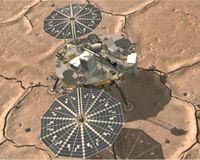 |
San Diego CA (SPX) Nov 09, 2010 Chemists at UC San Diego have uncovered a new chemical reaction on tiny particulates in the atmosphere that could allow scientists to gain a glimpse from ancient rocks of what the atmospheres of the Earth and Mars were like hundreds of millions years ago. Their discovery also provides a simple chemical explanation for the unusual carbonate inclusions found in a meteorite from Mars that was once thought by some scientists to be evidence of ancient Martian life. "We never knew before how the atmosphere could be trapped in carbonate," said Mark Thiemens, dean of UC San Diego's Division of Physical Sciences who headed the team of scientists that detailed its discovery in this week's early online edition of the Journal of the Proceedings of the National Academy of Sciences. "This chemical reaction, which takes place on the surface of aerosols in the atmosphere, not only provides us with an understanding of how these carbonates can form on the Earth and Mars. It gives us a new tool to better understand climate change, as our planet warms and becomes more dusty." Robina Shaheen, a postdoctoral researcher in Thiemens' laboratory, discovered the chemical reaction and detailed its importance in the Earth's atmosphere after four years of painstaking experiments in which she found a higher than expected proportion of oxygen 17 isotopes in the carbonates found on dust grains, aerosols and dirt from various parts of the world. Martian meteorites, such as ALH84001, which was once thought to exhibit evidence of extraterrestrial life, have carbonates with similarly high oxygen 17 anomalies. Scientists have long attributed those anomalies to photochemical processes involving ozone and carbon dioxide in the thin atmosphere on Mars, which is bathed by intense ultraviolet radiation. But after finding similar anomalies on terrestrial carbonates formed in atmospheric aerosols, Shaheen surmised they might be the result of another chemical process more common to both planets. She analyzed in painstaking detail in the laboratory and in the Earth's atmosphere how ozone molecules interacted with oxygen-bearing mineral aerosols from dust, sea spray and other sources to form hydrogen peroxide and carbonates containing this same oxygen-isotope anomaly. "What she found is that the tiny little layer on the outside of the grain is where this chemistry all happens," said Thiemens. "It's the ozone in the atmosphere mixing with water and carbon dioxide that drives a completely different kind of chemistry, one that's not in any of the models." While current models of atmospheric processes assume that the mixing of large volumes of gases drives the chemistry of the Earth's atmosphere, the UCSD chemists think their discovery may force a rethinking of this idea, particularly as the Earth's atmosphere becomes warmer and more dusty, providing more opportunities for this sort of chemistry to take place on aerosols. "You can do chemistry on a grain that's a lot quicker and easier in many respects than is possible in other atmospheric processes," said Thiemens. Shaheen, who analyzed the carbonates in the Martian meteorite ALH84001 and found that they could have been formed on aerosols in ancient Martian atmosphere, said that NASA's Phoenix lander recently detected carbonates associated with particulates in the dusty atmosphere of Mars. "We think it might be this same mechanism that is operating," she added. Besides understanding current and future atmospheric processes on the Earth and Mars, the new discovery offers the possibility of mining information about the Earth's atmosphere, particularly its oxygen levels, from carbonates found in ancient rocks millions of years ago, far beyond the time period from which scientists can now obtain information about the ancient atmosphere from ice cores. The development of this new tool to probe ancient atmospheres could be the most significant aspect of the UCSD chemists' discovery. "We've found a new way to measure the earth's atmosphere for time periods when we previously could not do it," said Thiemens. "What happened to ozone and oxygen levels 65 million years ago during the Cretaceous-Tertiary period when the dinosaurs and many other forms of life were killed in a mass extinction? Who died first? Did the food chain disappear before the dinosaurs? What happened 251 million years ago during the Permian-Triassic period, the most severe extinction of life on Earth, when 85 percent of life disappeared and no one knows why? There's no record of what happened in the atmosphere. But if you can find a record of what happened to oxygen levels, you can answer questions like that." Other researchers at UCSD involved in the study in Thiemens' laboratory were undergraduates Anna Abramian and John Horn. The research was partially supported by grants from National Aeronautics and Space Administration, the National Science Foundation and the UC San Diego Chancellor's Associates.
Share This Article With Planet Earth
Related Links UC San Diego Mars News and Information at MarsDaily.com Lunar Dreams and more
 Revealing More About The Atmosphere Of Mars
Revealing More About The Atmosphere Of MarsDallas TX (SPX) Oct 18, 2010 Instruments designed by a UT Dallas professor to measure atmospheric components on the surface of Mars have uncovered important clues about the planet's atmosphere and climate history. The findings, published in a recent issue of the journal Science, reveal how carbon dioxide isotopes have reacted to volcanic activity, water and weathering - thus forming a more complete picture of the curr ... read more |
|
| The content herein, unless otherwise known to be public domain, are Copyright 1995-2010 - SpaceDaily. AFP and UPI Wire Stories are copyright Agence France-Presse and United Press International. ESA Portal Reports are copyright European Space Agency. All NASA sourced material is public domain. Additional copyrights may apply in whole or part to other bona fide parties. Advertising does not imply endorsement,agreement or approval of any opinions, statements or information provided by SpaceDaily on any Web page published or hosted by SpaceDaily. Privacy Statement |